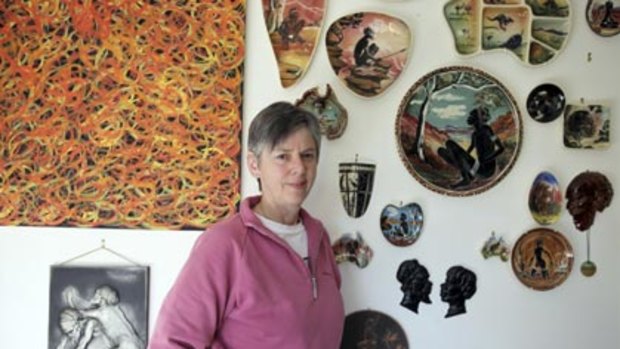Interest in collecting Australian ceramics continues to grow.
Next month there will be a major sale of the work of Melbourne artist Klytie Pate through Hurnall's Antiques & Decorative Arts and this week sees the final few days of an exhibition of Vande pottery at Sydney's Mosman Art Gallery.

Pot luck...Pip Chalmers started early.Credit: Fiona Morris
Vande was a Sydney commercial pottery that operated until 1958. It was one of the larger potteries in the 1950s, along with Studio Anna and Diana and Martin Boyd, with most of these companies catering to the new tourist market.
''For a long time souvenir pottery was considered kitsch,'' curator Donna Braye writes in the Mosman Art Gallery catalogue, ''however, in recent years it has become highly collectable.''
And increasingly valuable. Over the past 10 years prices for this style of work have skyrocketed on the secondary market. Braye suggests that Martin Boyd pieces tend to demand the higher prices, perhaps due to the famous Boyd name, ''although I suspect that his pottery had a slightly more stringent selection process'', she adds.
She has found that some of the Martin Boyd artists also worked for Vande and Studio Anna, which explains some of the design similarities.
Vande (pronounced Vander) was set up after World War II by Samuel Vandesluis, an English migrant with Dutch-Jewish heritage. Before the war he worked as a set decorator for film director and producer Alexander Korda. In Sydney he saw an opportunity for producing Australian pottery and took over an established business at 566 Military Road in Mosman.
He concentrated mainly on the growing demand for souvenirs. Vande produced thousands of wall plaques, ashtrays, dishes and savoury platters for gift shops and tourist centres but also made some larger one-off pieces that deserve to be placed in the fine art category. Some examples of these sold for more than $1000 at a recent Leonard Joel decorative arts auction.
All were hand-painted and, in most cases, the artist's initials or code is inscribed on the base. MEA or Mx stands for Marlene Adams, SZ for Suzie Little, Neen for Toni Coles, AM for Angela McMahon and BW for Beverly Wann. Others remain a mystery, like the AMP who created the wonderful cup and saucer sets shown below.
Adams, a talented young student from East Sydney Technical College, was one of Vande's first employees. She worked for several of the major potteries and in 1954 started her own pottery called Rohova, then another called Meroh.
Her early work with Vande is now considered significant. While there, it's believed she created the first foot-shaped souvenir, a novelty design widely copied by other souvenir manufacturers.
In some cases, silver or gold Vande labels may also be attached to the surface. If you find one, resist the temptation to peel it off. These add to the value.
The Aboriginal-inspired pieces are the most collectable today, following a period when such work was dismissed on moral or political grounds. At the time there was a fascination with traditional Aboriginal art, which was just starting to be appreciated in its own right. For ceramic artists this work would have been sourced through magazines such as Walkabout or Art in Australia, perhaps even tourist brochures.
Today ceramics in the Aboriginal style are seen in a positive light and several collectors now concentrate on this style, including Sydney enthusiast Alex Holland, who sold part of his massive collection through Leonard Joel earlier this year. He started in 1997, when he was one of the first to take this style seriously. Now it is a hot subject. ''Over time, the pieces have taken on a new meaning. Their original intent, as souvenirs, is no longer relevant and the artistry and variety of the work has been reassessed,'' Braye writes.
Australiana was another popular Vande theme, especially flora, with waratahs, flannel flowers, wattle and bottlebrush featured in many pieces. Some Jewish and Mexican themes were also covered.
This is a growing segment in the collectables market. The days of picking up important pieces for $5 in op shops may be over but there are still plenty to be found in the $50 to $100 entry-level range.
Braye mentions that though her exhibition is being held at the Mosman Art Gallery, much of what is displayed comes from the Mosman Library Local Studies collection. Libraries now collect and preserve all sorts of local material.
The Australian Accent exhibition at the Mosman Art Gallery, featuring the work of local design companies Vande Pottery and Annan Fabrics, finishes on Sunday.
My collection
Pip Chalmers is one of the more prolific collectors of Vande pottery. She also has work by other manufacturers but when she first discovered the Vande label back in 1999, something clicked and she now has 550 pieces.
Her collection ranges from souvenirs she has picked up for a few dollars in junk shops to signed one-off works that now fetch more than $1000 at auction.
Chalmers bought a few outstanding pieces from the recent Alex Holland sale through Leonard Joel. Some of her treasures are on loan to the Mosman Art Gallery for its current Vande exhibition.
While some collectors seem to have unlimited funds, Chalmers is a Toohey's brewery shift worker who operates on a tight budget. Still, the growing appreciation of Vande, plus the fact she started collecting early, means she already has a healthy investment.